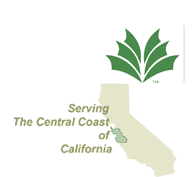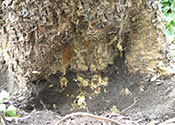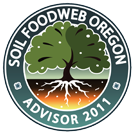Restoring an Oak Woodland
Unhealthy Oak Trees Need Help
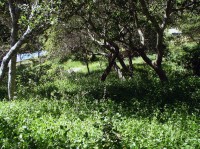 A one acre site is located in coastal Santa Cruz. Tree Solutions is asked to assess the health of several oak trees, (Quercus agrifolia) and recommend treatment. An initial observation shows an area overrun with vinca (Vinca major), which is growing up to three feet tall in the understory of these oaks. Many of the trees observed indicate stress and advanced decay at the base of trunk. Examples are: extensive bark checking, tissue damage, holes in the bark from boring insects, and leaf sprouting on areas of the lower stems all indicating an unhealthy condition. Many of the trees also have thinning canopies.
A one acre site is located in coastal Santa Cruz. Tree Solutions is asked to assess the health of several oak trees, (Quercus agrifolia) and recommend treatment. An initial observation shows an area overrun with vinca (Vinca major), which is growing up to three feet tall in the understory of these oaks. Many of the trees observed indicate stress and advanced decay at the base of trunk. Examples are: extensive bark checking, tissue damage, holes in the bark from boring insects, and leaf sprouting on areas of the lower stems all indicating an unhealthy condition. Many of the trees also have thinning canopies.
How Tree Solutions Restores the Oak Trees to Good Health
 The first step is the removal of the Vinca. This species of vinca is an invasive “non native” plant species. It is on the list of “Exotic Pest Plants of Greatest Ecological Concern in California” and this groundcover has an aggressive root system that competes with oaks for water and nutrients in the soil. This is especially important in the late summer and fall months because this plant has removed much of the available water in the soil creating additional water stress to the trees. In situations where we observe excessive amounts of vinca and ivy growing beneath tree stands, we also are seeing extreme tree stress, insect infestations and disease.
The first step is the removal of the Vinca. This species of vinca is an invasive “non native” plant species. It is on the list of “Exotic Pest Plants of Greatest Ecological Concern in California” and this groundcover has an aggressive root system that competes with oaks for water and nutrients in the soil. This is especially important in the late summer and fall months because this plant has removed much of the available water in the soil creating additional water stress to the trees. In situations where we observe excessive amounts of vinca and ivy growing beneath tree stands, we also are seeing extreme tree stress, insect infestations and disease.
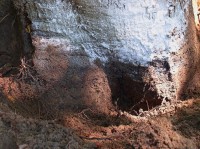 The second important procedure is cleaning of the root crown areas. This cleaning removes excess soil and leaf litter build up from the lower stem of the trees. Warm and moist soil surrounding what should be above-ground portions of the stem of a tree encourage growth of disease pathogens. By performing this cleaning, air is allowed to move freely around the base of a tree thus eliminating an optimum growing condition of stem-damaging pathogens.
The second important procedure is cleaning of the root crown areas. This cleaning removes excess soil and leaf litter build up from the lower stem of the trees. Warm and moist soil surrounding what should be above-ground portions of the stem of a tree encourage growth of disease pathogens. By performing this cleaning, air is allowed to move freely around the base of a tree thus eliminating an optimum growing condition of stem-damaging pathogens.
Third, the needs of the growing environment are addressed. A representative soil sample is taken and analyzed. Based on the results of the soil sample, fertilizer is sub-surface injected and broadcast to address the immediate nutrient deficiencies of the soil. A cocktail of mycorrhizal fungus, bacteria, kelp extract and humic acids are added to the soil food web.
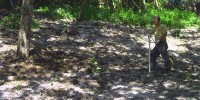 Fourth, a layer of oak mulch is added to the area. We feel it is important to use naturally occurring mulch materials, and match these materials to the trees growing in the environment. Mulch will provide food for the soil microbes, fungi, etc. This assures that the already occurring organisms and those added from the above mentioned cocktail will have a food source available to help maintain the soil food web. Mulch also helps regulate soil temperature and moisture levels.
Fourth, a layer of oak mulch is added to the area. We feel it is important to use naturally occurring mulch materials, and match these materials to the trees growing in the environment. Mulch will provide food for the soil microbes, fungi, etc. This assures that the already occurring organisms and those added from the above mentioned cocktail will have a food source available to help maintain the soil food web. Mulch also helps regulate soil temperature and moisture levels.
All of the above procedures are intended to return the growing environment to a condition that allows a tree to rebuild its defense systems and reverse decline.
